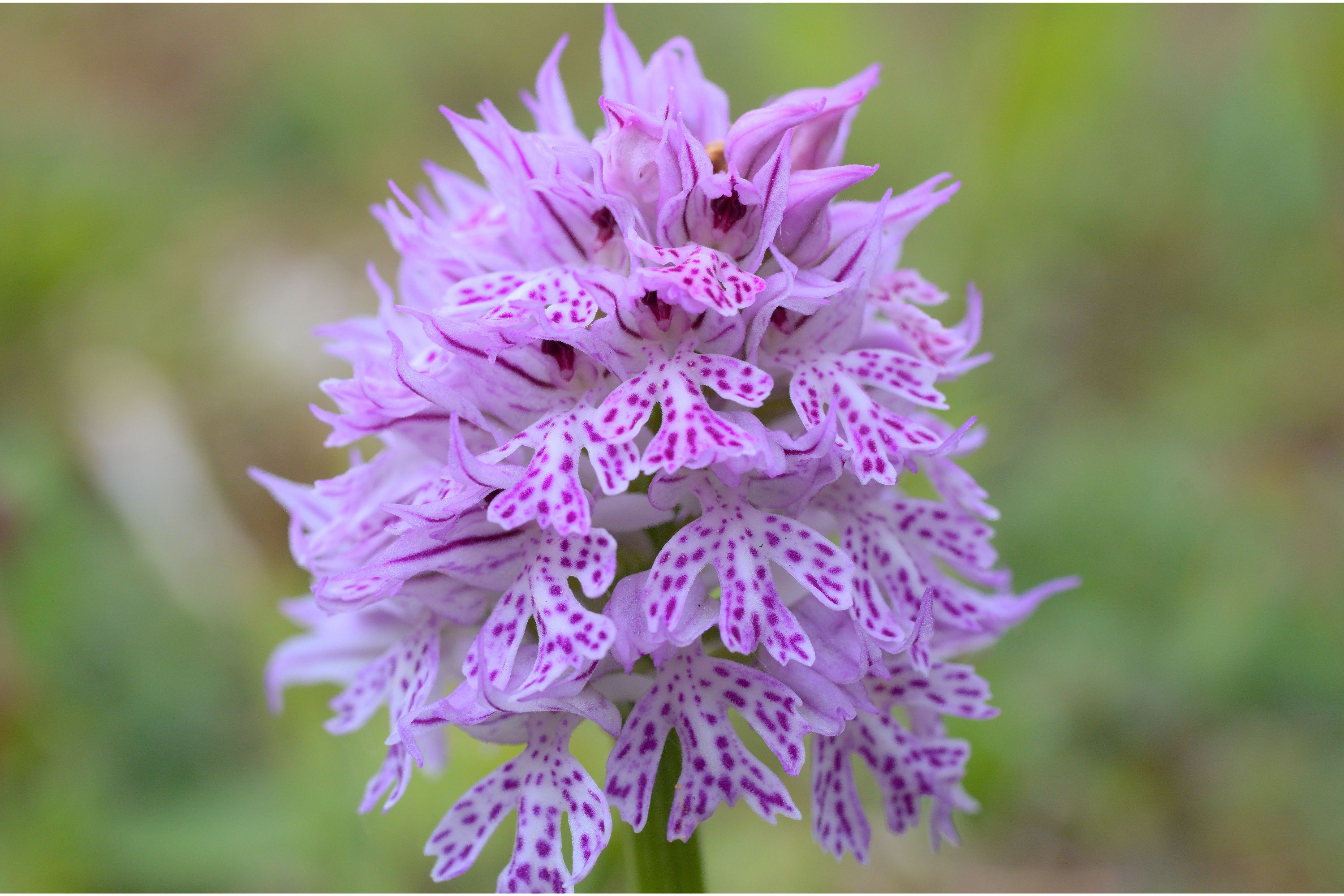Three-toothed Orchid
(Neotinea tridentata)

Description
Neotinea tridentata, commonly known as the Three-toothed Orchid, is a captivating species of orchid that belongs to the genus Neotinea. With its delicate beauty and intriguing morphology, this Mediterranean native has enchanted botanists and nature enthusiasts alike. In this article, we will delve into the world of Neotinea tridentata, exploring its taxonomy, morphology, distribution, habitat, life cycle, and conservation status. Taxonomy Neotinea tridentata belongs to the Orchidaceae family, which is renowned for its diverse and exquisite floral forms. It was first described by the Italian botanist Giovanni Gussone in 1843. The genus name, Neotinea, is derived from the Greek word "neo" meaning "new" and the Latin word "tinea" referring to a type of moth. The specific epithet, tridentata, is derived from the Latin words "tri" meaning "three" and "dentatus" meaning "toothed," alluding to the distinctive trident-shaped lip of the flower. Physical Appearance Neotinea tridentata, commonly known as the Three-toothed Orchid, exhibits a distinct and delicate physical appearance. Here is a detailed description of its physical characteristics: Size and Structure: Neotinea tridentata is a small-sized orchid, typically ranging in height from 10 to 30 centimeters. It has a slender and erect stem that supports the flowers and leaves. Leaves: The leaves of Neotinea tridentata are arranged in a basal rosette. The basal leaves are elongated, lanceolate, and typically green in color. They have parallel veins and smooth margins. Towards the upper part of the stem, the leaves become reduced in size and sheath-like. Inflorescence: The inflorescence of Neotinea tridentata is a loose spike that bears several flowers. The flowering spike emerges from the top of the stem. The number of flowers per spike can vary, but usually, there are several flowers present. Flowers: The flowers of Neotinea tridentata are the highlight of its physical appearance. They come in various shades of pink, lavender, or white. The flowers are relatively small, but their intricate structures make them visually captivating. Lip: The most striking feature of Neotinea tridentata's flowers is the trident-shaped lip, from which it derives its common name. The lip is deeply lobed and divided into three pointed segments, resembling the shape of a trident or a pitchfork. The lip serves as a landing platform for pollinators. Sepals and Petals: Neotinea tridentata has three sepals and three petals. The sepals and petals are narrow, elongated, and often have a lighter color compared to the lip. They form a graceful backdrop to the prominent lip. Fragrance: The flowers of Neotinea tridentata may emit a faint fragrance, although the intensity and specific scent can vary among different populations. It's important to note that there can be some variation in the physical appearance of Neotinea tridentata, such as slight color variations in the flowers. Additionally, individual plants within a population may exhibit some variability in their physical characteristics. Distribution and Habitat Neotinea tridentata, the Three-toothed Orchid, is primarily found in the Mediterranean region. Its range extends across several countries, including: Spain: Neotinea tridentata can be found in various regions of Spain, particularly in the central and southern parts of the country. Portugal: It occurs in certain regions of Portugal, mainly in the southern and central parts. France: Neotinea tridentata is present in France, specifically in the southern parts of the country, including the Mediterranean coast and Corsica. Italy: It is widespread throughout Italy, occurring in different regions from the north to the south, including the Italian islands such as Sicily and Sardinia. Greece: Neotinea tridentata can be found in various parts of Greece, particularly in the southern and eastern regions of the country. Balearic Islands: It is also known to occur in the Balearic Islands, including Mallorca, Menorca, Ibiza, and Formentera. Habitat: Neotinea tridentata occupies diverse habitats within its range, demonstrating its adaptability to different environmental conditions. It is commonly found in open woodlands, rocky slopes, grasslands, and scrublands. The species can thrive in both natural and disturbed habitats. In terms of altitude, Neotinea tridentata has been recorded from sea level up to 2,000 meters, depending on the local climate and geographical characteristics of its habitat. This wide altitudinal range allows the species to inhabit various mountainous regions as well. Within its preferred habitats, Neotinea tridentata often grows in soil that is nutrient-poor and well-drained. It can tolerate different soil types, including sandy, rocky, and calcareous soils. The orchid tends to favor areas with ample sunlight, although it can also tolerate some shade. While Neotinea tridentata is primarily associated with the Mediterranean region, it is important to note that its precise distribution and habitat requirements can vary within its range. Local climatic conditions, soil composition, and other ecological factors may influence its distribution patterns within each country or region where it occurs. Life Cycle The life cycle of Neotinea tridentata is a fascinating journey, revolving around the intricate relationship between the plant and its pollinators. This orchid species displays a remarkable reproductive strategy known as deceptive pollination. It mimics the appearance and scent of female solitary bees, attracting male bees that attempt to mate with the flower. During the flowering period, which typically occurs from April to June, the male bees mistakenly perceive the lip of Neotinea tridentata as a receptive female bee. As they land on the flower, they come into contact with the pollinia, which are sticky, pollen-bearing structures. The pollinia attach to the body of the deceived bee, and as it flies off to search for another "mate," it inadvertently transfers the pollinia to another flower, accomplishing pollination. Following successful pollination, the flowers of Neotinea tridentata wither away, and the plants redirect their energy towards seed production. The seeds are tiny and numerous, and they are dispersed by wind, aided by the presence of minute hairs on the seed surface. This mechanism allows for potential colonization of new habitats, ensuring the survival and genetic diversity of the species. Conservation Status and Threats Neotinea tridentata, like many orchid species, faces several conservation challenges due to habitat loss, degradation, and unsustainable land use practices. The International Union for Conservation of Nature (IUCN) has classified Neotinea tridentata as a species of "Least Concern" as of the knowledge cutoff in September 2021. However, it is crucial to monitor its population dynamics and habitat conditions to prevent any decline in the future. The main threats to Neotinea tridentata include urbanization, agricultural expansion, and changes in land management practices. The conversion of natural habitats into urban areas or agricultural fields results in the loss of suitable environments for the orchid. Additionally, intensive land management practices, such as the use of herbicides, pesticides, and excessive grazing, can negatively impact the populations by directly affecting their survival and reproductive success. Furthermore, the disturbance of natural habitats through recreational activities, such as trampling or picking flowers, can also harm the delicate populations of Neotinea tridentata. Therefore, public awareness campaigns and responsible ecotourism practices are essential to mitigate these human-induced threats. Conservation Efforts Efforts are underway to conserve and protect Neotinea tridentata and its habitats. Several conservation measures can be implemented to ensure the long-term survival of this captivating orchid species: Habitat Protection: Identifying and protecting key habitats, such as nature reserves, protected areas, and Natura 2000 sites, is crucial for safeguarding Neotinea tridentata populations. This involves collaboration between government agencies, conservation organizations, and local communities. Habitat Restoration: Rehabilitating degraded habitats and restoring natural vegetation can help provide suitable conditions for Neotinea tridentata to thrive. This may involve reducing invasive species, promoting sustainable land management practices, and reestablishing native plant communities. Research and Monitoring: Continued research and monitoring efforts are essential to understand the population dynamics, reproductive biology, and ecological interactions of Neotinea tridentata. Long-term studies can provide valuable insights into the species' responses to environmental changes and guide conservation strategies. Public Engagement and Education: Raising awareness about the importance of orchid conservation and the ecological significance of Neotinea tridentata is crucial. Educating local communities, landowners, and visitors about responsible behavior and the value of preserving natural habitats can help minimize human impacts on the species. Conclusion Neotinea tridentata, the Three-toothed Orchid, is a captivating species that adds beauty and diversity to the Mediterranean flora. Its elegant form, intricate lip, and deceptive pollination strategy make it a subject of fascination among botanists and nature lovers. While the species currently holds a "Least Concern" conservation status, proactive measures are necessary to protect its habitats, mitigate threats, and raise awareness about its ecological importance. By implementing effective conservation strategies, we can ensure the long-term survival of Neotinea tridentata and preserve the delicate balance of our natural ecosystems.
Taxonomic tree:







